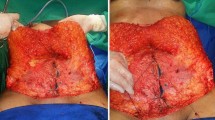Abstract
Background
Umbilicoplasty is an important surgical procedure in abdominoplasty, regardless of the technique used. An unaesthetic umbilicus often irreversibly affects surgical outcomes. This study describes the experience of our team with the subdermal neo-umbilicoplasty technique and assesses patient satisfaction with the appearance of the new umbilicus.
Methods
Fifty-eight patients with abdominal deformity underwent abdominoplasty with subdermal neo-umbilicoplasty. Patients were followed up for at least 1 year with photographic documentation, assessment of patient satisfaction, and evaluation of eventual postoperative complications.
Results
Postoperative complications included one case of shallow umbilicus, four cases of superficial necrosis, and one case of midline deviation. No patient required surgical revision. There was a high level of patient satisfaction with the natural-looking umbilicus.
Conclusions
Subdermal neo-umbilicoplasty resulted in low postoperative complications and provided a new, natural-looking umbilicus without external scars.
Level of evidence: Level IV, therapeutic study















Similar content being viewed by others
References
Dobou R, Ousterhout DK (1978) Placement of the umbilicus in an abdominoplasty. Plast Reconstr Surg 64:291–293
Dogan T (2010) Umbilicoplasty in abdominoplasty: a new approach. Ann Plast Surg 64(6):718–721
Bruekers SE, van der Lei B, Tan TL, Luijendijk RW, Stevens HP (2009) “Scarless” umbilicoplasty: a new umbilicoplasty technique and a review of the English language literature. Ann Plast Surg 63(1):15–20
Malic CC, Spyrou GE, Hough M, Fourie L (2007) Patient satisfaction with two different methods of umbilicoplasty. Plast Reconstr Surg 119(1):357–361
Franco T, Franco D (1999) Neoomphaloplasty: an old and new technique. Aesthetic Plast Surg 23(2):151–154
Craig SB, Faller MS, Puckett CL (2000) In search of the ideal female umbilicus. Plast Reconstr Surg 105(1):389–392
Lee MJ, Mustoe TA (2002) Simplified technique for creating a youthful umbilicus in abdominoplasty. Plast Reconstr Surg 109(6):2136–2140
Pardo Mateu L, Chamorro Hernandez JJ (1997) Neo-umbilicoplasty through a purse-string suture of three defatted flaps. Aesthetic Plast Surg 21(5):349–351
Pfulg M, Van de Sijpe K, Blondeel P (2005) A simple new technique for neo-umbilicoplasty. Br J Plast Surg 58(5):688–691
Rozen SM, Redett R (2007) The two-dermal-flap umbilical transposition: a natural and aesthetic umbilicus after abdominoplasty. Plast Reconstr Surg 119(7):2255–2262
Amud RJM (2008) Omphaloplasty without scars. Rev Bras Cir Plast 23:37–40
Nogueira DSC (2008) Routine neoomphaloplasty during abdominoplasties. Rev Bras Cir Plast 23:207–213
Nahas FX (2001) A pragmatic way to treat abdominal deformities based on skin and subcutaneous excess. Aesthetic Plast Surg 125:365–371
Nahas FX (2001) An aesthetic classification of the abdomen based on the myoaponeurotic layer. Plast Reconstr Surg 108(6):1787–1795
Likert R (1932) A technique for the measurement of attitudes. Arch Psychol 140:1–55
McKnight CL, Fowler JL, Cobb WS, Smith DE, Carbonell AM (2012) Concomitant sublay mesh repair of umbilical hernia and abdominoplasty. Can J Plast Surg 20(4):258–260
Author information
Authors and Affiliations
Corresponding author
Ethics declarations
Funding
There was no external funding for this study.
Conflict of interest
Alejandro Povedano, Gabriel Salum D’Alessandro, Lauren Klas Iurk Leme dos Santos, Alexandre Mendonça Munhoz, Rolf Gemperli, and João Carlos de Sampaio Góes declare that they have no conflict of interest.
Ethical approval
All procedures performed in this study involving human participants were in accordance with the ethical standards of the institutional and/or national research committee and with the 1964 Helsinki declaration and its later amendments. However, for this type of retrospective study formal consent from a local ethics committee is not required.
Patient consent
Informed consent was obtained from all individual participants included in the study.
Rights and permissions
About this article
Cite this article
Povedano, A., D’Alessandro, G.S., dos Santos, L.K.I.L. et al. Subdermal neo-umbilicoplasty in abdominoplasty. Eur J Plast Surg 41, 335–344 (2018). https://doi.org/10.1007/s00238-017-1374-z
Received:
Accepted:
Published:
Issue Date:
DOI: https://doi.org/10.1007/s00238-017-1374-z




